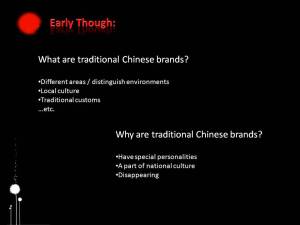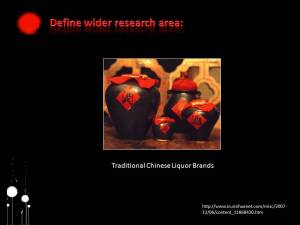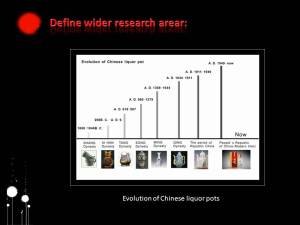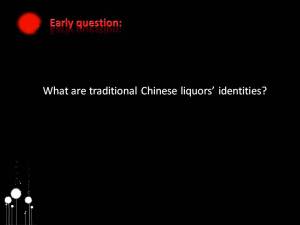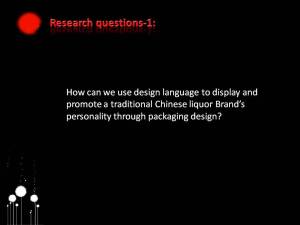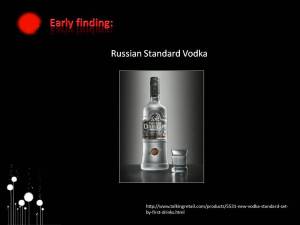PGC Presentation
At the beginning of the PGC Phase, our Need must project group was investigate into Nottingham art and design areas. We found culture is the most significant part in Art and design. So relate to my MA research project, I want to my project is connect with culture elements. Therefore, I beagn to think some contexts about culture and what culture can connect with my branding and identity design.
When I surveyed the different cultural contexts, I found my country “traditional brands” will be the good topic in my research project. Therefore, in my research project I want to investigate into traditional Chinese brands and create their visual identities.
First I want to explain, what are traditional Chinese brands?
In China, according to different areas and distinguish environments, people follow their local culture, traditional customs, local lifestyle…etc. to build their traditional brands. These brand have a long history, some of the traditional Chinese brands have over hundred years history. They have become a unique symbol in my country or even on a global scale. Thus,traditional Chinese brands have become part of national culture and Chinese history.
Second I want to explain, why are traditional Chinese brands?
First, I very proud of my country’s traditional brands, I know they history better than other countries’ traditional brands. Every different scale’s traditional brands are the typical forms and have the special personalities which can stand for their local culture. But the most important that reason I choose traditional Chinese brands for my topic it is in today’s world, most of traditional brands are inundated by modern brands. These brands are becoming increasingly popular, and consumers have stopped buying traditional products. Maybe in a few years’ time, they will forget our country’s traditional brands and products. Therefore, to explore a new way of traditional brand’s visual identity design is the significant part of my MA course. The new identity design can help our traditional brands stand out in the competitive market and can attract audience’s attention. It will help people have more opportunities to know our traditional brands.
Although I chose traditional Chinese brands for my topic, traditional has different species. Therefore, I must choose one typical type which has more connect with national culture and Chinses history of my research area. After the deep surveyed, I defined traditional Chinese liquor brands for my wider research area.
The reason why I chose it for my wider research is, traditional Chinese liquors have over thousands years history. As we can see this picture “evolution of Chinese liquor pots”, we can know that every period has its won typical liquor pot. And every stage’s liquor pot is designed by the significant culture. The shapes and the materials were showing the specific culture identities. Moreover, in China, liquor could also call the “Water of history” and the messages of liquor can be found in almost every pages of Chinese history
On the other hand, In our modern society,traditional liquors have become the most important medium in Chinese people’s life. For example:
For Celebrate: people always use liquor to celebrate the happiness time or the important events in their life.
For traditional festivals, in the traditional festivals, family members will come together, they will drink liquors and eat traditional food.
For friends: meet new friend, liquors also serves effectively to deepen and strengthen friendship.
For business: businessmen want to communicate with other people and find more opportunites..
For health: Chinese people do believe that moderate drinking of liquor is good for the health.
Therefore, traditional liquor has played an important role in Chinese social culture. We can’t take it away from our people’s life. And these reasons why I chose traditional liquor for my MA research project.
When I researched the liquor data on the Internet. I found that lot of traditional Chinese liquor brands always use common design and packaging techniques to brand their product.As we can see these 24 different area’s traditional liquor’s packaging design, they use the same elements, like dragon, Chinese calligraphy. They also use the same colours, like red, gold. These brands have come from different areas, but I can’t identify their visual identity. In my opinion, I think they are come from the same area or belongs to the same brand. So, Where are their individuall personalities?
Therefore, “What are traditional Chinese liquors’ identities?” has become my early question.
After the deep research, I think according to different traditional liquor brands have come from different areas. Therefore, the distinguished local environments, local culture, traditional customs, local materials …etc. are affect the liquors’ brew process. I think these things can stand for the traditional Chinese liquors’ personalities.
These personalities will connect with my branding packaging design. Therefore, I have the first question:”How can we use design language to display and promote a traditional Chinese liquor Brand’s personality through packaging design? “
Traditional Chinese liquors have different species, thus I must choose one typical liquor brand for my target research and help it to create a new visual idenitity. Therefore, I chose the most famous liquor which called “Dong” liquor for my target brand. This famous brand is comes from my home town- Zunyi city. Moreover I want to add some new idea for my packaging design and I want to intorudce my home town’s trdaitional liquor for oversea consumer. Thus,I chose U.K consumers for my audience and I want to introduce my home town “Dong” liquor in the U.K. marketplace.
So, my second question is:
“How can we use visual elements to help “Dong” liquor introduce itself and stand out in the U.K. market? “
After I made this question, I didn’t know from which area I can investigate and find the visual elements for “Dong” liquor. And my supervisor gave me a great advice that maybe I could investigate other country’s traditional alcohol brands and find what process they use to design the brand’s visual identities. So, I found a Russian traditional vodka brand for my case studies. This vodka brand is called Russian standard vodka. It’s the most famous premium brand in the world.
After the studied , I found that Russian has a powerful connect with it’s national culture. It uses national culture to comebine with it’s pacakaging design. For example:
Shape of the vodka bottle: the unique bottle design which is inspired by the Great Bell Tower in the heart of Moscow, which is a characteristic of traditional Russian orthodox churches.
The standard logo: the brand’s logo which combines with bear, eagle and crown is the most special logo in the world. This elegance logo is involving the significant symbol in Russian history and the important year of Russian Standard Vodka. The eagle, original one is the Byzantine double-headed eagle. This symbol was adopt by the Russian tsars as their own royal symbol. The bear is the national personification for Russia. The bear stand for Russia’s ancestor, moreover Russian bear is a national spirit in the national culture.
The Russian standard vodka let me know which culture elements I can investigate into my visual research for “Dong” liquor. And I thought “Dong” liquor original place’s culture is the key point of my research project.
Moreover, for the “Dong” liquor brand, it’s local culture is important part in my project. But for the U.K audiences, the important is question is “where this liquor brand has come from?”
So I had the third question:
“How can we let the U.K. audience know that “Dong” liquor has come from China and help them to easily identify this as a traditional Chinese brand? “
I thought choose the most typical traditonal Chinese art form combine with the visual identity that can help U.K. audience easily identified this brand has come from China. In the future, I will investigate into the image of a typical Chinese traditional are form in the mind of the U.K. audience. And I will add this type of art form in my brand’s packaging design which will help U.K. audinces easliy identify my target brand as Chinese.
Methodologies:
1. Quantitative: through questionnaires, research data and experiments.
2. Qualitative: through literature, interviews and case studies.
Methods:
Research data:
- Visual research:
I will use different processes of visual research to gather cultural visual elements and collect “Dong” liquor historical data in Zunyi city.
- Literature research:
I will review literature about local culture and local liquor history in the Zunyi Library.
Case studies:
As my research product which is a traditional Chinese liquor brand and this brand has different class liquor which is similar to the Scotch single malt whiskey. I will to go Scotland to investigate into Scotch single malt whiskey brands and choose 2 or 3 brands for my case studies. I will also research into Scotch history and Scotch whiskey culture to find how they have used elements of their local culture in their branding identity design.
Interview:
- I’ll interview my target brand’s consumers and record their reflections about “Dong” liquor.
- I’ll interview Zunyi local historians and record the data of local culture and liquor’s history.
Questionnaire:
The aim of this questionnaire is to know and ensure what people know and don’t know about Chinese traditional liquor. The questions will be about the main features of Chinese traditional elements, culture symbols and I will study the image of a typical Chinese traditional art form in the mind of the U.K. audience. I will add this typical traditional art form in my brand’s visual identity design which will help U.K. audiences easily identify my target brand as Chinese.
Experiments:
I will experiment and use 2D graphic design and 3D packaging design combined with traditional Chinese art forms to create a new line of “Dong” liquor’s visual identity. Moreover, I will test my designs in the U.K. marketplace. Therefore, I can gather the reflections from my U.K. audiences and will use these reflections to help me review and recreate my experiments.
Submissions:
Research report:
Visual research report: it will include my visual data and elements gathered from my investigation of marketplace in U.K. and China.
Written research report: it will include the research report, the questionnaire findings report and interview analysis report.
Design work:
Design will be developed throughout the research process to explain the idea. This identity design will be presented visually through sketches and experiments (2D graphics design and 3D packaging design). The final outcome design work will include logo design, packaging design and the brand’s introduce handbook.
Reflective journal:
It is a visual diary (online blog) which will present all the steps, research procedures, design processes, critical review and learning outcomes of my project.
In the PGD Phase, I will research in my specific area and analyisis my data. After that, I will develop my visual elements, draw up target brand’s visual strategy. Identified the design approcah. At the end of PGC Phase, I will hand in my design concept.
In the MA Phase, I will use visual questionnaire to testing my design concept. I will develop my 3D pacaking design and introduce handbook. At the MA expo. I will hand in we complete work.
For the next stage , I will use my Christmas holiday that go back to China and investigate into my specific brand. In China I will:
Investigate “Dong” liquor’s visual history and its place in the local culture of Zunyi city.
Interview target brand’s consumers, local historians, and to explore a local liquor museum.
Explore international liquor brands’ retail environments and visual identity design in Guangzhou marketplace.
A designer’s research manual:
- Introduce and understand what design research is.
- Outline proven research techniques and methods.
- Explain how to incorporate these methods in design project.
On brand: A tour de force the world’s leading authority on branding.
Yes logo: The best branding design company- 40 years of Michael Peters branding, design and communication.
After I finished my presentation, my classmate asked me a question about my target brand’s name. My target liquor brand’s name is “Dong” liquor. For me, I can understand the name-“Dong” is traslate to Chinese pronunciation. But for the U.K people “Dong” is not a word and it hasn’t meaning. So, “how can U.K audience can memorize this strange name?”is become to a problem. I thought this question is a good topic. The name must has a signficant meaning in brand’s visual design, especially in the packaing design. Therefore, In my project, I will follow my research data and analyse “Dong” liquor brand’s meaning. After that, I will translate the meaning into English words and I will create a new English brand’s name for “Dong” liquor. I hope the new brand name can be engage U.K. audience’s attention.


